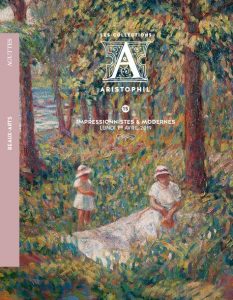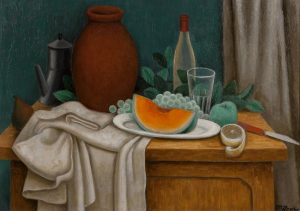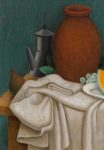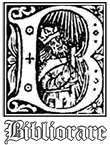JEAN METZINGER (1883-1956). La tranche de melon, 1923. Huile sur toile, signée en bas à droite. 65.5 x 92 cm - 25 3/4 x 36 1/4 in.
Description
Le certificat, rédigé en date du 19 mai 2004 par Madame Bozena Nikiel, et indiquant l'insertion au catalogue raisonné en préparation sera remis à l'acquéreur.
PROVENANCE
Vente Bellier, Drouot, Paris, 25 février 1953
Collection particulière, Paris
Vente Artcurial, Paris, 20 octobre 2007
Collections Aristophil.
La toile que nous présentons offre une parfaite synthèse de l'attachement à une peinture traditionnelle et des préceptes cubistes que Metzinger avait défendus puis abandonnés en 1921 pour s'orienter vers ce qu'il a appelé un «réalisme constructif ». Ici en effet, ce sont les volumes et les interactions tant sur le plan chromatique que linéaire des objets qui importe. Metzinger ne reviendra au cubisme qu'après la Deuxième Guerre Mondiale.
The painting presented here perfectly synthesises Metzinger's attachment to traditional painting and the Cubist precepts he had upheld and then abandoned in 1921 for what he called «constructive realism». Here the important aspect is the volumes and the interactions of the objects in both chromatic and linear terms. Metzinger only returned to Cubism after the Second World War.
JEAN METZINGER (1883 - 1956)
S’il a pu se laisser toucher d’abord par les théories impressionnistes et divisionnistes, Jean Metzinger est avant tout l’un des hérauts du cubisme dont il a contribué à définir les fondements qu’il a voulu récapituler dans un essai co-rédigé en 1912 avec Albert Gleizes. il faut rappeler en effet que l’artiste n’est pas seulement un peintre de talent, mais aussi un théoricien et critique d’art, un écrivain et un poète.
L’artiste fréquente le Bateau-Lavoir rapidement après son arrivée à Paris en 1903. C’est à l’Abbaye de Créteil, communauté littéraire et artistique, qu’il rencontre Gleizes. Ses talents littéraires lui permettent d’évoquer avec emphase les talents de ses contemporains actifs à Montmartre: Delaunay, Le Fauconnier, Braque et Picasso, qui l’avait orienté vers le cubisme, comptent parmi les noms qu’il aime à évoquer régulièrement, et avec emphase dans ses écrits.
Ce sont ces mêmes artistes qui l’intègrent à la Section d’Or, ou groupe de Puteaux, qui s’est distingué lors de l’exposition des Indépendants en 1911. Metzinger, adepte d’un cubisme analytique s’épanouit pleinement dans ce mouvement qui permet, à ses yeux, d’explorer toutes les perspectives d’un objet, qu’il fragmente indéfiniment, sans être prisonnier des points de vue et visions traditionnels.
Cependant, à partir de 1911, il propose une vision moins fragmentaire des sujets qu’il représente, au point d’en simplifier l’étude le plus possible. Si ses premières oeuvres ont fait l’objet de sévères critiques, l’essai rédigé en 1912 lui vaut une reconnaissance certaine, et un poste à l’Académie de la Palette puis à l’Académie Arenius. Il expose désormais en France et à l’étranger. L’artiste s’installe à Bandol de 1943 à 1950 avant de revenir à l’Académie Frochot en tant que professeur.
While initially influenced by Impressionist and Divisionist theories, Jean Metzinger was first and foremost a forerunner of Cubism. He helped to define its basic tenets, then summarised them in an essay co-written with Albert Gleizes in 1912. As we know, the artist was not only a gifted painter, but also an art theorist and critic, writer and poet. Soon after his arrival in Paris in 1903, he was rapidly drawn to the world of the Bateau-Lavoir. He met Gleizes at the Abbaye de Créteil, a literary and artistic community. His literary gifts enabled him to write speakingly on the talents of contemporary ar tists active in Montmartre; those he mentioned regularly included Delaunay, Le Fauconnier, Braque and Picasso, who had introduced him to Cubism.
The same artists welcomed him to the Section d’Or, or Puteaux Group, which made a striking impression at the exhibition of the Indépendants in 1911. Metzinger, a follower of analytical Cubism, found full expression in this movement, feeling that it enabled him to explore the perspectives of an indefinitely fragmented object without being imprisoned by conventional viewpoints and visions.
However, in 1911, he put forward a less fragmentary vision of the subjects he represented, simplifying their study as much as possible. While his first works attracted harsh criticism, the essay he wrote in 1912 won him solid recognition and posts at first the Académie de La Palette and then the Académie Arenius. He now exhibited in France and abroad. He lived in Bandol between 1943 and 1950 before returning détail to the Académie Frochot as a professor.







